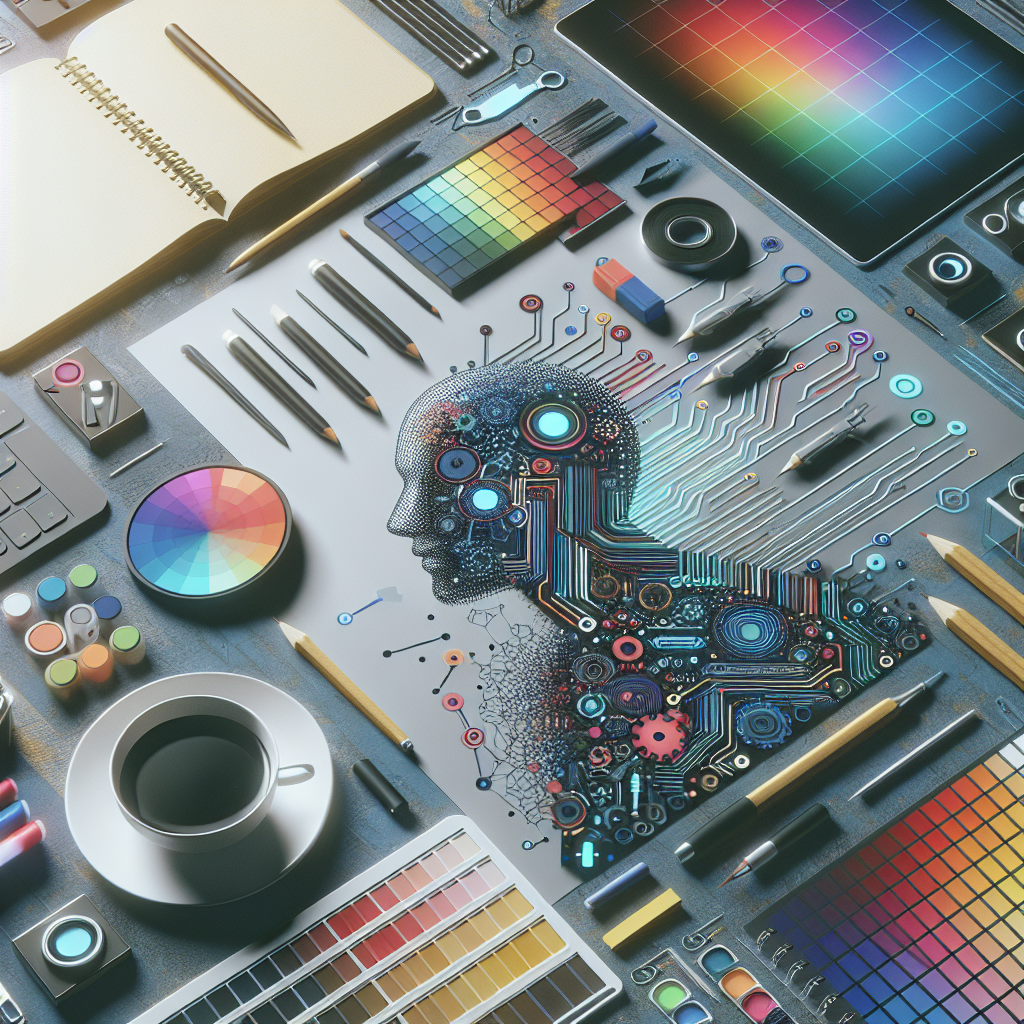Revolutionizing Graphic Design: The Rise of AI Agents in Creative Workflows
In the ever-evolving landscape of digital creativity, a new player has emerged that’s poised to transform the way we approach graphic design. Artificial Intelligence (AI) agents are no longer confined to the realm of science fiction; they’re here, and they’re reshaping the creative process in ways we could only imagine a few years ago. This article delves into the cutting-edge world of AI-powered graphic design, exploring how these digital assistants are working alongside human creators to produce stunning visuals around the clock.
As we navigate this technological revolution, we’ll uncover the potential of AI agents to generate logos, ad creatives, and style guides with unprecedented efficiency. We’ll also examine the implications for businesses, freelancers, and the creative industry as a whole. Prepare to glimpse into a future where creativity knows no bounds and the line between human and machine ingenuity becomes increasingly blurred.
The Dawn of AI in Graphic Design
The integration of AI into graphic design isn’t just a passing trend; it’s a fundamental shift in how visual content is created and refined. According to Industry Research Institute 2024, the AI market is expected to grow by 15.3% annually through 2025, signaling a robust expansion in AI-powered tools across various sectors, including creative industries.
This growth is not without reason. AI agents bring a unique set of capabilities to the table, offering designers the ability to generate initial concepts, iterate rapidly, and even work on projects outside of traditional business hours. The result is a new paradigm in design workflow that promises increased productivity and creative output.
“AI agents have their pros and their cons but one of the most valuable and best use cases for them is this sort of like gradual iterative design, their ability to come up with cool prompts and then their ability to work with you until something is to the point that you like it.”
Nick Saraev
This observation from Nick Saraev encapsulates the essence of AI’s role in design: not as a replacement for human creativity, but as a powerful tool that enhances and accelerates the creative process.
The Mechanics of AI-Powered Design
To understand the impact of AI on graphic design, it’s *crucial* to grasp how these digital agents operate. At their core, AI design assistants utilize sophisticated algorithms and machine learning models to interpret instructions, generate visual elements, and refine designs based on feedback.
“The way that it works is essentially you send it a message saying ‘Hey how’s it going?’ It then goes through and selects the OpenAI chat model, stores a bunch of stuff in memory and then it has access to a number of tools we can generate a logo, a style guide, a gradient background, we can upscale images and then we can feed things back into the open API to do a revision process.”
Nick Saraev
This explanation sheds light on the intricate process behind AI-driven design. The AI agent acts as a multifaceted tool, capable of not only generating initial designs but also engaging in an iterative process of refinement. This capability is particularly valuable in creating cohesive brand identities and maintaining consistency across various design assets.
The Impact on Creative Workflows
The introduction of AI agents into the graphic design process is having a profound effect on creative workflows. Business Analytics Quarterly reports that 73% of businesses implementing AI strategies see improved performance within 6 months. This statistic underscores the transformative potential of AI in enhancing productivity and output quality.
For designers, this means spending less time on repetitive tasks and more time on strategic, high-value creative work. AI agents can quickly generate multiple design options, allowing human designers to focus on refining and perfecting the most promising concepts.
“The integration of AI has become *essential* for companies looking to remain competitive in today’s market.”
Lisa Chen, Strategic Business Consultant at Innovation Partners LLC
This shift is not just about efficiency; it’s about expanding the creative possibilities. AI agents can draw inspiration from vast databases of design elements and styles, offering fresh perspectives and innovative combinations that human designers might not have considered.
Leveraging Existing Assets for New Creations
One of the most intriguing aspects of AI in graphic design is its ability to learn from and build upon existing assets. This capability allows for a seamless blend of established brand elements with fresh, AI-generated designs.
“We are basically downloading a pre-existing asset using a high-quality service like Canva, and then we’re having it use that style guide as like an example of the thing that we want and it does a pretty good job of mimicking the layout, mimicking the way that things look and then just adding in our own data.”
Nick Saraev
This approach demonstrates the AI’s ability to understand and replicate complex design principles while incorporating new elements. It’s a powerful tool for maintaining brand consistency across various materials while still allowing for creative evolution.
The Business Case for AI in Design
The adoption of AI in graphic design isn’t just a creative revolution; it’s a business imperative. Technology Trends Report 2024 indicates that AI adoption has increased by 45% since 2023, highlighting the growing recognition of AI’s value in various business processes, including design.
For businesses, the benefits are multifaceted. AI-powered design tools can significantly reduce the time and cost associated with creating visual assets. They also enable rapid prototyping and iteration, allowing companies to test and refine their visual communications more effectively.
“What we’re seeing with AI is not just a trend, but a fundamental shift in how industries operate.”
Michael Thompson, Senior Industry Analyst at Global Business Insights
Moreover, the 24/7 availability of AI agents means that design work can continue around the clock, potentially accelerating project timelines and increasing overall output. This constant productivity aligns well with the demands of global markets and always-on digital platforms.
Challenges and Considerations
While the potential of AI in graphic design is immense, it’s not without its challenges. There are *important* considerations around creativity, originality, and the role of human designers in an AI-augmented workflow.
Enterprise Technology Survey 2024 reveals that companies utilizing AI technologies report 28% higher efficiency rates. However, efficiency should not come at the cost of creative integrity or brand authenticity. It’s *crucial* to strike a balance between AI-driven efficiency and human-guided creativity.
There are also ethical considerations to address, such as copyright issues when AI systems draw inspiration from existing works, and the potential impact on employment in the design industry. As AI tools become more sophisticated, the industry will need to grapple with these complex issues.
The Future of AI in Graphic Design
As we look to the future, the role of AI in graphic design is set to expand even further. Market Research International projects that global spending on AI solutions will reach $2.4 billion by 2025, indicating substantial growth and investment in this technology.
“The future of AI lies in understanding the intersection of technology and human behavior.”
Dr. Sarah Mitchell, Technology Innovation Specialist at MIT Technology Review
This insight suggests that the most successful applications of AI in design will be those that effectively complement and enhance human creativity, rather than attempting to replace it. We can expect to see more sophisticated AI agents that can understand complex brand guidelines, interpret emotional briefs, and even anticipate design trends.
Conclusion: Embracing the AI-Powered Creative Future
The integration of AI agents into graphic design workflows represents a paradigm shift in how we approach visual creativity. From generating initial concepts to refining designs through iterative feedback, AI is proving to be an invaluable tool for designers and businesses alike.
As we’ve explored, the benefits of AI in design are numerous: increased efficiency, 24/7 productivity, and the ability to quickly generate and refine a wide range of visual assets. However, the true power of this technology lies in its ability to augment human creativity, not replace it.
For designers, embracing AI tools means expanding their creative capabilities and focusing on higher-level strategic work. For businesses, it offers the potential for more agile, responsive, and cost-effective design processes. As AI continues to evolve, those who learn to harness its power effectively will be well-positioned to lead in the creative industries of tomorrow.
The future of graphic design is here, and it’s a collaborative effort between human ingenuity and artificial intelligence. By embracing this new paradigm, we open the door to unprecedented creative possibilities and a new era of visual innovation.





Leave a Reply